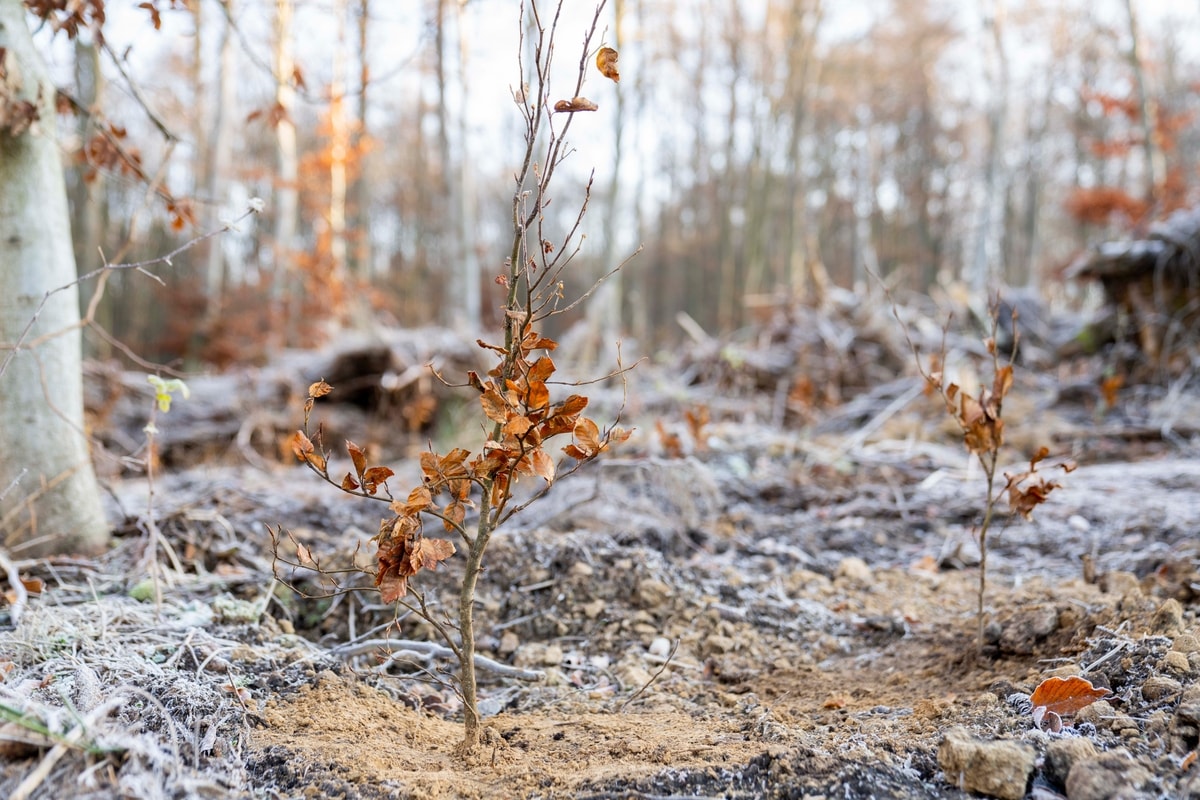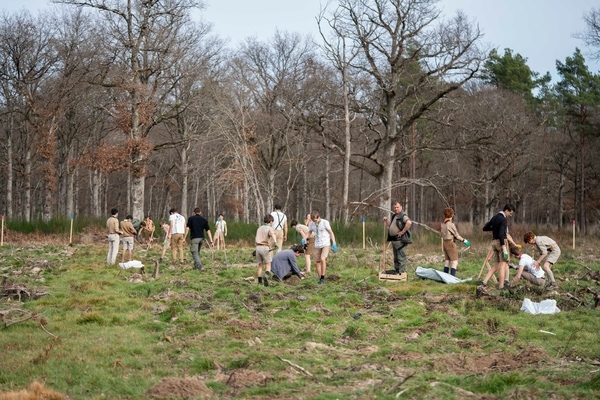Starting with forest areas near our company locations in the Hanover region, our planting and forest care projects have now expanded.
With the lavera Forest Project, we aim to breathe new life into climate-stressed forests in Europe through reforestation and renaturation measures. For us, this also includes preserving valuable natural areas through maintenance measures - and thus maintaining their diverse fauna and biodiversity.
Find out where we are active with lavera and how we are helping the forest habitat in the video and in more detail on this page.
Planting Area at Stemmer Berg, Hanover Region
Climate change does not spare the Calenberg Land, Hannover region, either. The tree population suffers from drought, especially on south-facing slopes, making weakened trees more susceptible to diseases or dying from bark beetle infestation. At Stemmer Berg, approximately 3.5 hectares of forest have disappeared. With funds from the lavera forest project, around 6,000 more climate-resilient trees were planted over an area of about 1 hectare by the Nedden forestry company. The planted climate-stable trees include Sessile oaks, Red oaks, Norway maples, European white elms, and Hornbeams. Sweet chestnuts and Wild cherries were also planted at the forest edge.

Karwendel Nature Park
In Tyrol, lavera supports the largest and oldest nature park in Austria, the Karwendel Nature Park, which performs valuable work in the areas of nature conservation, recreation & tourism, environmental education, and knowledge & research.
In 2023, lavera is funding a total of five out of the thirteen alpine pasture maintenance measures: Without support, the alpine pasture owners would not be able to maintain these important cultural landscapes and have therefore been included in the alpine pasture maintenance program of the Karwendel Nature Park.
Volunteer helpers, under the guidance of the Karwendel Park team, clear the alpine pastures of rockfall and wild bush growth, repair fences, clean bodies of water, or gather hay on the mowed areas.
It is not only the current action in the interest of nature that is close to our hearts but also raising awareness on these topics. Therefore, with the help of the lavera forest project, two nature rangers are also being trained.
Chambord Planting Project
In collaboration with the Life Terra Foundation, the Plantons pour l'avenir Foundation Fund, and the Scouts Unitaires de France, the Lavera Thomas Haase Foundation planted 8,729 trees at the Chambord National Estate, with lavera donating more than half of them.

Experts have selected trees for the current planting campaign that can cope with little water and are less affected by temperatures up to 40 degrees: 2,494 Black pines, 1,793 Calabrian pines, 1,003 Sessile oaks, 815 Coastal redwoods, 690 Turkish oaks, 490 Holm oaks, 2,856 American red oaks, 220 Service trees, and 210 Sorb trees were planted.
Lombardy
Forests influence our climate. In our reforestation project, we take into account the natural regeneration of the forest. This means trees that have self-seeded are integrated into the plantations. The sustainable forests of tomorrow are mixed forests with a variety of broadleaf and coniferous tree species.
Forests have a direct impact on global and regional climate. A healthy forest also has many positive effects on the fauna and flora, the groundwater level, as well as the quality of water and air.
We inhale about 12,000 liters of air daily. Trees use light, water, and carbon dioxide to produce vital substances such as glucose and oxygen through a process called "photosynthesis."
The German forest alone, with its 11.4 million hectares, produces 1 to 1.5 times the amount of oxygen that German citizens need to breathe each year.
Furthermore, forests cool the air and improve air quality in urban areas through air exchange.
Every tree secures its growth through photosynthesis, converting carbon dioxide into glucose and oxygen. The carbon remaining in the wood is used for wood growth and is only released again when the wood burns or rots.
Forests therefore lower the carbon dioxide content in the air, which is harmful in high concentrations. Each hectare of forest sequesters an average of 8 tons of CO2 per year. Additionally, the forest in Germany alone stores 58 million tons of CO2 annually through its growth.
Deciduous trees such as chestnuts contribute to a healthy forest climate. Unlike pines, chestnuts have deep roots that revitalize the forest floor. Their canopy protects smaller trees, plants, and the forest floor from strong sunlight and drying out.
At the same time, chestnut, like all deciduous trees, channels rainwater along its trunk deep into the forest floor through its funnel-shaped branch structure. This improves groundwater supply and helps the entire forest withstand dry periods. Their leaves also form a layer of humus, providing important nutrients for a healthy forest.





